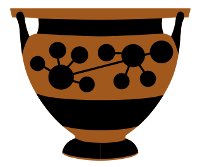Next week I will be heading to Oxford for the AHRC-funded face-to-face meeting for the Linked Art scientific committee. On Tuesday is a showcase workshop at the Victoria & Albert Museum that I sadly cannot attend, but I have put together a small slideshow with notes that I think Sami Norling from the Indianapolis Museum of Art at Newfields will read (since the Linked Art JSON-LD harvester is built around test examples from the IMA). The slides are as follows:
Kerameikos.org is an
international project that seeks to define the intellectual concepts
of ceramics studies following the principles of Linked Open Data.
This phase of the project is funded by the US National Endowment for
the Humanities and is focused primarily on creating URIs for Archaic
and Classical Greek pottery concepts, which includes authoring
definitions for shapes, artists, techniques, production places, etc.
and linking them to equivalent entries in other LOD thesauri, such as
the Getty and British Museum vocabularies and the Pleiades Gazetteerof Ancient Places. We are also aggregating vase data from partner
collections as a proof of concept to facilitate new types of query
and visualization. The emerging Linked Art community plays a
significant role in this process.
The Indianapolis
Museum of Art at Newfields has a small collection of Greek vases that
have served as a test case for building a harvester that integrates
Linked Art-compliant JSON-LD into Kerameikos' Linked Open Data
ecosystem. This vase pictured here in the IMA, represented by a URI,
is a particular shape called a stamnos. It was painted by Hermonax,
an Athenian artist, in the Red-figure technique in roughly the
mid-5th century B.C.
In a test of JSON-LD
provided by Sami Norling at the IMA, some minor modifications were
made to fill in any gaps in cataloging with the relevant Getty Art &
Architecture Thesaurus, Union List of Artist Names, and Thesaurus of
Geographic Names identifiers. These URIs have equivalencies in
Kerameikos.org and other systems.
The harvesting
workflow parses the Linked Art JSON-LD and distills it into the most
basic network graph, represented here as RDF/XML conforming to the
the underlying Linked Art profile in the CIDOC CRM ontology. The
human-readable labels from the JSON, which may be useful to
developers working directly with that format of data, are removed,
since the preferred labels in English and other languages are already
inherent to Kerameikos.org's own thesaurus data model.
After entering basic
metadata about a dataset (in this case, the IMA's collection of Greek
vases) and a link to the JSON-LD file on a web server (which will one
day be a URL for an API response), the harvester will extract the
JSON and process each human-made object into RDF/XML, replacing Getty
URIs with Kerameikos ones, when applicable. After this completes, the
RDF is published to the Kerameikos.org SPARQL endpoint. SPARQL is a
query language for linked data, and the underlying triple database is
the backbone of aggregation in this project, as well as Nomisma.org,
a similar linked data project for numismatics.
After the workflow
completes, the vases will immediately become available in the pages
associated with concepts connected to the IMA's vases, for example
kerameikos.org/id/stamnos or kerameikos.org/id/hermonax. This user
interface can accommodate multiple jpeg images per vase, as well as
IIIF services and several types of 3D models rendered in the 3D Hop
library or the Sketchfab viewer.
By means of the
relationship between the Getty Thesaurus of Geographic Names,
Kerameikos.org place identifiers, and the Pleiades Gazetteer of
Ancient Places, it is possible to build a transformation process that
converts Linked Art RDF into a different RDF data model required by
the Pelagios Network. Kerameikos.org is now a data hub for Pelagios,
and currently about 200 Greek vases from 6 partners are available in
the Peripleo explorer. This number will grow into the thousands in
the coming months and years as the full range of British Museum,
Getty, and archaeological pottery are integrated into Kerameikos.
In conclusion, as
the Linked Art standard begins to proliferate throughout the museum
community, harvesting will be greatly simplified by having one set of
APIs and models that can be applied broadly across many museum or
archaeological databases, rather than relying on intermediate
processes of OpenRefine data cleaning and spreadsheet-to-RDF
transformation with one-off programming scripts.










